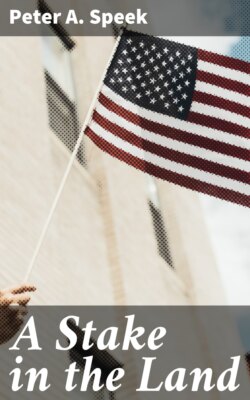Читать книгу A Stake in the Land - Peter A. Speek - Страница 8
На сайте Литреса книга снята с продажи.
AUTHOR'S NOTE
ОглавлениеTable of Contents
This report summarizes the results of a preliminary survey of rural developments in the United States from the viewpoint of the Americanization of immigrant settlers conducted by the writer for the Study of Methods of Americanization.
The field study covered a period of about four months, from June to September, 1918, inclusive, during which time the writer with his wife, Frances Valiant Speek, as his assistant, visited fifty-four cities and rural immigrant colonies in New England, the North Middle Western, the Western, and the Southwestern states. The cities and colonies visited and the nationalities involved are given in the order followed in the field study:
| 1. | New York, N. Y. | |
| 2. | Vineland, N. J. | Italians |
| 3. | " | Jews |
| 4. | " | Russian co-operative farm |
| 5. | Alliance, N. J. | Jews |
| 6. | Norma, N. J. | Jews |
| 7. | Woodbine, N. J. | Jews |
| 8. | Willington, Conn. | Bohemians |
| 9. | " | Slovaks |
| 10. | Portsmouth, R. I. | Portuguese |
| 11. | Fall River, Mass. | Portuguese |
| 12. | South Deerfield, Mass. | Poles |
| 13. | " | Lithuanians |
| 14. | Oneida, N. Y. | Italians |
| 15. | Canastota, N. Y. | Italians |
| 16. | Detroit, Mich. | |
| 17. | Lansing, Mich. | |
| 18. | Holland, Mich. | Dutch |
| 19. | Au Gres, Mich. | Germans from Russia |
| 20. | " | Germans from Germany |
| 21. | Posen, Mich. | Poles |
| 22. | Rudyard, Mich. | Finns |
| 23. | " | Canadian French |
| 24. | Madison, Wis. | |
| 25. | Radisson, Wis. | Poles |
| 26. | Exeland, Wis. | Mixed |
| 27. | Conrath, Wis. | Poles |
| 28. | Weyerhauser, Wis. | Poles |
| 29. | Holcombe, Wis. | Mixed |
| 30. | Wausau, Wis. | Mixed, Germans and native-born predominating |
| 31. | Three Lakes, Wis. | Poles |
| 32. | Jennings, Wis. | Poles |
| 33. | New Rhinelander, Wis. | Italians |
| 34. | Roxbury, Wis. | Germans |
| 35. | Walworth County, Wis. | Germans |
| 36. | St. Paul, Minn. | |
| 37. | St. Cloud, Minn. | Slovenians |
| 38. | " | Germans |
| 39. | Fargo, N. D. | Scandinavians, Swedes, Norwegians |
| 40. | Bismarck, N. D. | |
| 41. | Dickinson, N. D. | Russians |
| 42. | " | Germans |
| 43. | San Francisco, Cal. | Russian Sectarians |
| 44. | " | Japanese |
| 45. | Sacramento, Cal. | |
| 46. | Fresno, Cal. | |
| 47. | Los Angeles, Cal. | Russian Sectarians |
| 48. | Glendale, Ariz. | Russian Sectarians |
| 49. | Phœnix, Ariz. | |
| 50. | Globe, Ariz. | |
| 51. | Austin, Tex. | |
| 52. | Lincoln, Neb. | Germans |
| 53. | Milford, Neb. | Germans (Mennonites) |
| 54. | Chicago, Ill. |
In addition to observation of the conditions in the colonies, numbers of the immigrant settlers, their leaders, native neighbors, and local public officials were interviewed on the subject of the survey. This was later supplemented by research, conducted mainly by the writer's assistant in the Library of Congress. No attempt was made to collect facts and material in a quantitative sense, attention being concentrated on what seemed to be outstanding facts, conditions, and cases.
In the writing of this summary the writer, as an immigrant himself, has also used his own experiences and earlier observations beginning in 1909, and his observations during his field investigation of the conditions of floating laborers in this country for the United States Commission on Industrial Relations during 1913–15.
The fundamental conclusion at which the writer has arrived in this summary is as follows:
The establishment of a home may involve direct material assistance, but requires protection, direction, and instruction given to the home-seeking and home-building immigrants. These aspects of the problem are discussed in Part I.
In the question of education the instruction of adult immigrants as well as immigrant children is important. Among all educational agencies the public school is the foremost. The parochial school and Catholic and Lutheran churches are, in many of the districts studied. Part II discusses the relative efficacy of public and private educational agencies in tying the immigrant into American life and loyalties.
P. A. S.
